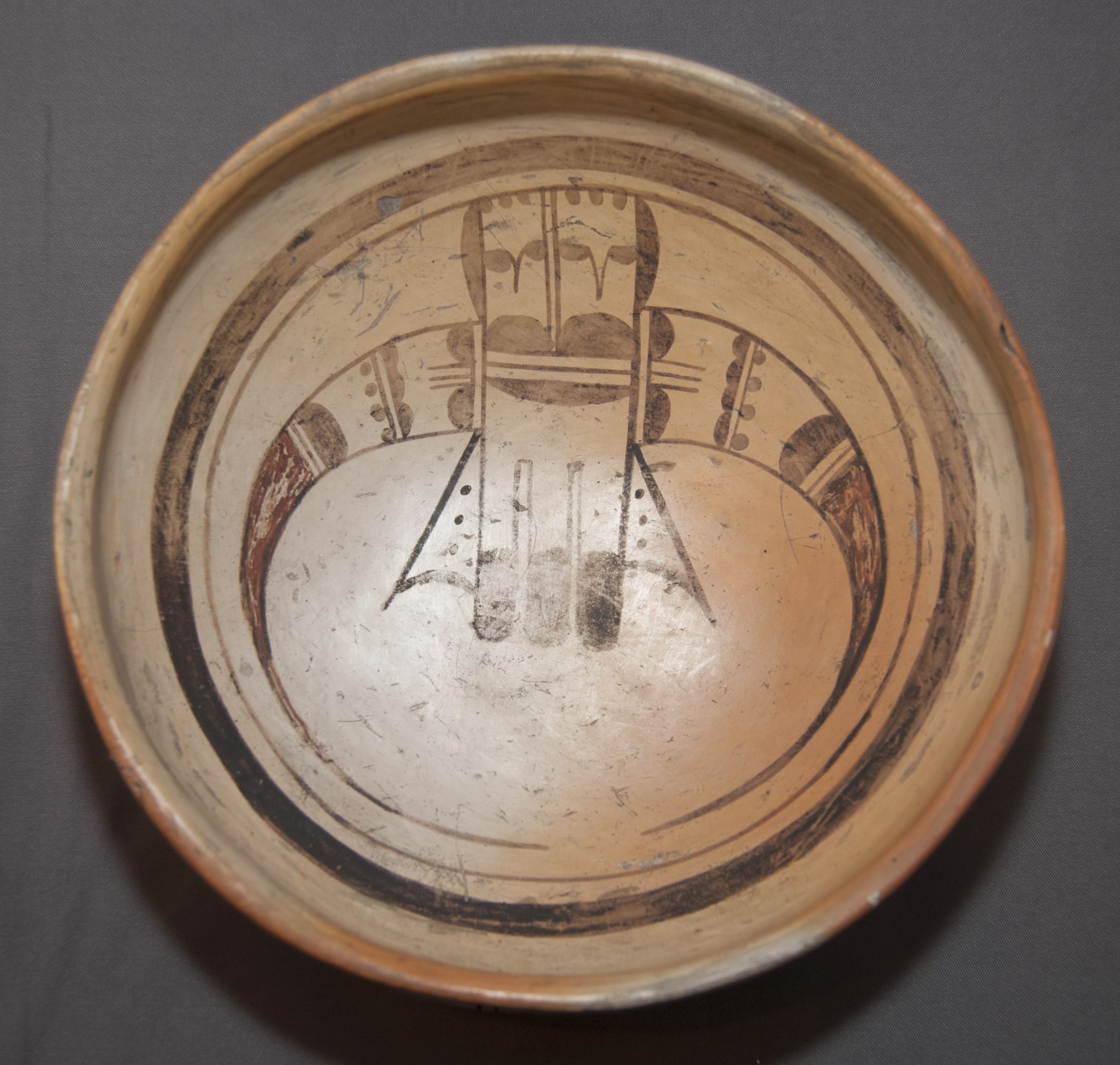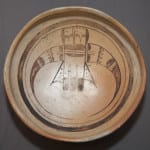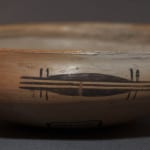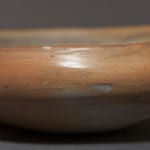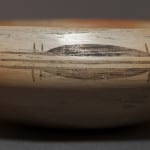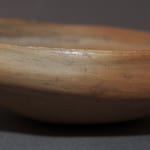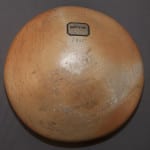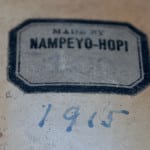The form of this small bowl is unusual: Most Hopi and Hopi-Tewa bowls have spherical bodies (often with a flat base). This little bowl has steep conical sides that rise from a flat base and a short, vertical rim. The juncture between the base and the rim is sharp, which suggests that the base might have been formed in a pot-starting form (tabipi) with the short rim simply added to the base form. The rim is also unusual: it is slightly everted on the outside but protruding on the inside, which gives the appearances of the “extra rim coil” that the Blairs say is characteristic of Nampeyo bowls (1999:91). The bowl, however, does not have an extra coil of clay on the inner rim.
The overall interior design on this bowl is a single abstract bird within thick-above-thin framing lines. Nampeyo regularly used avian elements in her designs, but generally these elements are disjointed and rearranged into an abstract design. (For example, see 1993-04, 1996-05, 2002-03, and 2006-02.) On bowl 2011-16 you get a whole bird in flight, though abstracted. The core of the bird is linear, and its head contains two “clown face” designs that are characteristic of Nampeyo’s work (Kramer 1996:188). Three linear tails mark the rear of the bird. These rear elements are framed by two “tail fins” that would look at home on a 1955 Ford. Anchored by the midsection of the body core, two curvilinear wings sweep out about 6.5 inches past the rear of the body core. About ¾ of this arc is painted with rust-red paint, the only color in the design. Overall, the design is somewhat worn and is faded in spots.
The design on the bowl is pure Nampeyo. In Appendix B, Section #3 I defined six characteristics of Nampeyo’s mature style:
1) A tension between linear and curvilinear elements, often represented as a contrast between heavy and delicate elements.
2) A deliberate asymmetry of design.
3) The use of color to integrate design elements.
4) The use of empty (negative) space to frame the painted image.
5) The use of a thick above a thin framing line on the interior rim of her bowls.
6) Confident, bold, and impulsive painting.
Bowl 2011-16 displays all of these design markers:
1) The linear core body of the bird contrasts with the curvilinear form of every other element in the design, most notably the wings. The black ends of the three tail feathers are stubby and blunt; the ends of the wings narrow down to a thin red line. The light curved ends of the “tail fins” sharply contrast with the stubby black ends of the linear tails to which they are attached.
2) From one point of view, the design is symmetrical. The head of the bird is divided into two parts, each with a clown face. A narrow channel separates the two sections of the head. If you fold the design along this channel, the bottom wing would rest atop the upper wing, and the lower design elements of the body core would coincide with the top elements. From this point of view, the design is symmetrical—the most symmetrical of any Nampeyo pot in the collection.
Obviously, if you fold the design so that the head of the body core is folded back towards its tail, the design is completely asymmetric. Moreover, the design is not centered within the framing lines. The body core touches the thin framing line on one side of the bowl and stretches about 2/3 of the distance to the opposite side of the bowl. The remaining third of the bowl is largely empty, and displays only the thin red ends of the wings, which reflect the thin framing line. This design resembles a spaceship in a Star Wars movie. The “spaceship” has a strong thrust towards one side of the bowl.
The physical center of the bowl is on the linear tails at the point where the unpainted surface ends and the black paint begins. If you place a piece of paper at this point cutting across the tail so that only the rear of the design is visible, it is very clear how little of the image is painted in the uncovered half of the bowl. Had Nampeyo centered the body of the bird within the framing lines and then arranged the wings within the remaining space, the design would have been balanced—and substantially less interesting.
3) At first glance, the design looks monochromatic. With a longer look, it is apparent that the thin segments of the wings are painted a dark, rust red. Because the overall design is faded, it is not clear if these red areas were more vibrant when the pot was new. The integrative function of this color is less pronounced on this pot than on other Nampeyo pots in the collection (see 2005-16) but is similar to the modest use of color on her four-moth pot (see 2008-06). On both of these latter pots only thin areas of wings are highlighted in dark red. If Nampeyo had painted some element in the body core red, the integrative function of color would have been clear—though the aesthetic effect of this change is uncertain. My definition of her six design strategies is formulaic; Nampeyo’s ceramic genius was not constrained by such rules.
4) As noted above, the body core of the design is pressed up against the thin framing line and extends about two-thirds of the distance to the opposite framing line. The thin wings largely encircle the resulting empty space. Much of this blank space is thus incorporated within the design and yet, at the same time, it highlights the “tail fins” and linear tails at the rear of the avian image. A similar function is performed by the thin curved wings on Nampeyo’s eagle tail pot (2005-16).
5) As expected, the design is encircled by thick-above-thin framing lines. The format is not unique to Nampeyo, but is characteristic of her “Sikyatki Revival” bowls.
6) The painting on bowl 2011-16 is confident and somewhat impulsive compared to the more-studied, plotted, and careful style of her daughters, descendants, and other Hopi and Hopi-Tewa potters. For example, while the “head” of the avian image is bifurcated, the division is not equal. The upper segment is wider than the lower segment. While the design elements in both segments are the same, the narrowness of the lower segment forced Nampeyo to paint the lower eye of the “clown face” out of line. (This suggests she painted the “eyes” from the top to the bottom.) On the wings there is a design consisting of three curved elements on one wing; on the other wing this design has four elements. One “tail fin” extends further to the rear than the other; as a result, the pointed ends are drawn differently. Finally, the opening left by the two curved wings is not centered on the avian body but instead occurs entirely above the central axis of this body. These irregularities are not flaws; Nampeyo’s work is in a folk art tradition. Instead, these unequal elements contribute to the asymmetry of the design (#2 above) and give energy to the overall design. The design is confident and bold; the execution is impulsive and not exact. In the space between these parameters is Nampeyo’s genius.
The exterior design on the bowl is a simple rendition of a cloud emblem with two vertical lines at either end, repeated twice on opposite sides of the bowl (Patterson 1994:141).
On the bottom of the bowl, written with a fountain pen, appears the name “M. S. Coulton”
(?) and the date “1915.” Presumably, M. S. Coulton was an owner of the pot, and “1915” could have been the date it was purchased or came into her/his possession. A production date of 1915 seems reasonable.
While bowl 2011-16 is a “classic” Nampeyo pot and meets all of the six criteria discussed above, it is not a “great” Nampeyo pot—nor was it intended to be. (See Appendix D for an evaluation of Nampeyo pots in this collection.) As indicated by the Harvey “Made by Nampeyo—Hopi” on the bottom, this pot was probably made fairly quickly to fill a order from the Harvey Company for a specified number of pots, with the paper label added by a Harvey employee after delivery. Below the printed words on the label, very faintly written in pencil, is the original price: $1.00.
This is the second pot in the collection with a “Made by Nampeyo – Hopi” label. The first is pot 2010-20. In spite of the Harvey label, pot 2010-20 was almost certainly not made by Nampeyo; it’s more likely the product of one of her daughters learning the craft, likely Nellie. See the catalog entry for 2010-20 for a more through discussion of the Harvey “Nampeyo” stickers. The collection also has pots by Annie (1999-13) and Fannie (2012-04) that carry the Harvey “from the Hopi Villages” label. Together this subset of four pots (1999-13, 2010-20, 2011-16, and 2012-04) attest to the close commercial relationship between The Harvey Co. and the Nampeyo family, thus underscoring that Nampeyo’s “Sikyatki Revival” was rooted in an Anglo market.
A large jar (ASM #GP52543) with this same label is part of the Arizona State Museum, Tucson.
See: www.statemuseum.arizona.edu/exhibits/nampeyo/details/gp52543.shtml

